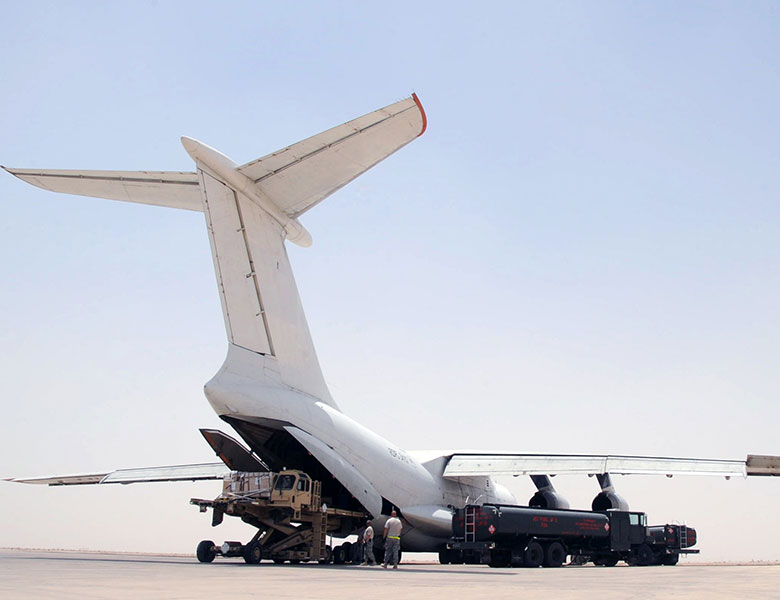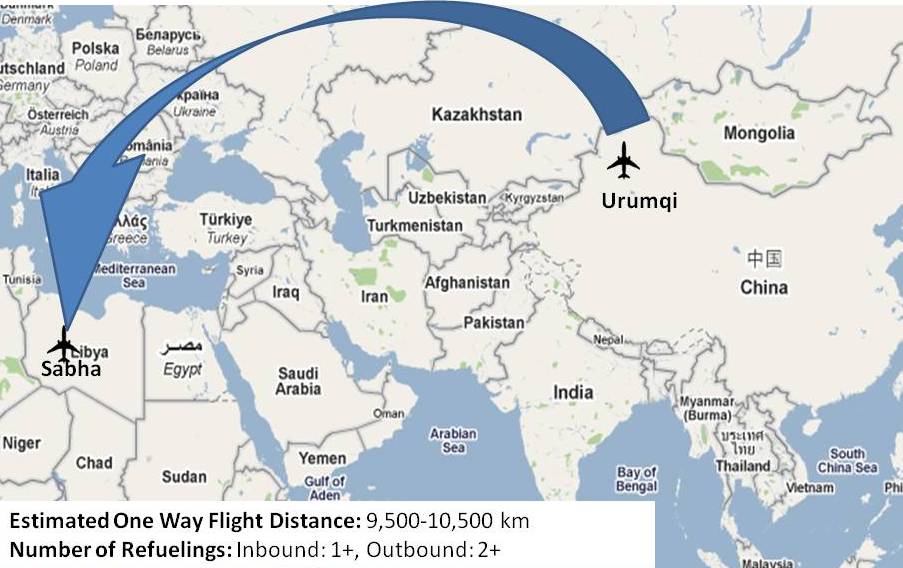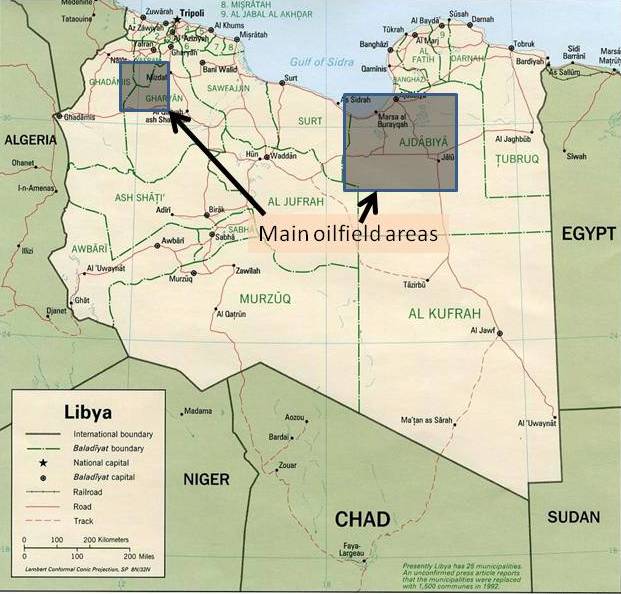China’s evacuation of its citizens from Libya became a multi-service operation on the afternoon of 28 February 2011, when the PLA Air Force (PLAAF) flew four IL-76 long-range transport aircraft from Diwopu International Airport in Urumqi, Xinjiang Uyghur Autonomous Region (Northwest China). Their destination: Sabha, in east-central Libya. According to China Central Television (CCTV)-7, Beijing’s official military channel, the mission is to rescue Chinese citizens “stranded” in Libya. The PLAAF’s deployment of assets into a theater where the PLA Navy already has the Xuzhou missile frigate scheduled to arrive in waters off Libya very shortly sets an historic precedent for deploying military assets to protect Chinese nationals abroad.
The deployment is the longest range PLAAF air deployment yet that we know of. Turkish media report that Chinese SU-27’s refueled in Pakistan and flew via Iran to Turkey in mid-September 2010 for a bilateral air exercise, Anatolian Eagle, in Anatolia. The flight distances involved in the Libya rescue operation are several thousand km further than the 2010 mission and likely involve total distances of between 9,500 and 10,500 km, depending on route and wind and weather conditions. Deploying aircraft from the headquarters location of the Xinjiang Military Region Air Force in Urumqi makes sense, as it offers the shortest flight to Libya. A stylized great circle route (the shortest theoretical flight path) is depicted below (Exhibit 1).
Exhibit 1: Potential flight routes for China’s IL-76 deployment
Source: Associated Press, People’s Daily, China SignPost™
Based a typical IL-76 range of ~6,500 km with a light load and ~3,600 km fully loaded (Jane’s Aircraft Upgrades; exact range would vary with aircraft variant, engine condition, and payload), we estimate the fleet would need to make at least one refueling stop on the way to Libya and at least two stops on the way home, depending on winds and weather and the route chosen. The PLAAF would need to use designated airways (authorized transit corridors), whose structure is complicated, and which can be closed because of weather, military exercises, or political reasons. Airways structure and availability typically adds 10-15% more distance than the theoretical route depicted above, wind patterns and other weather conditions add perhaps ~15% more distance, and the refueling strategy and locations chosen by the PLA potentially still more distance. Refueling locations might be chosen for political reasons, and based on the availability of clean, reliable fuel. Turkey might be a preferred location for refueling, given China’s 2010 participation in Anatolian Eagle there, and the refueling of Chinese military aircraft (e.g., the JF-17 export fighter) there en route to the 2009 Farnborough Air Show (Aviation Week & Space Technology). Jet stream air currents will likely lengthen flight time (and increase fuel consumption) on the way to Libya, and shorten flight time (and reduce fuel consumption) on the way back to China. A Boeing 747, for example, requires ~9.5 hours to make a commercial flight from Beijing to Frankfurt, Germany, as opposed to only ~8 hours returning with a tailwind.
Drivers of the mission
The mission’s timing comes too late to assist the vast majority of Chinese previously trapped in Libya, who are now either back in China, en route, or safely gathered in third countries. Relatively few Chinese citizens remain in Libya, with at least 29,000 of the estimated 30,000 originally in Libya evacuated, according to the South China Morning Post. That said, 1,000 citizens trapped in a volatile country still poses major security and humanitarian concerns. Libyan pro-government forces have reportedly been attacking anti-regime groups in Eastern Libya and the town of Zawiya near Tripoli, and no Chinese wish to be caught in the crossfire.
The Libyan Air Force has also allegedly been conducting airstrikes against anti-regime forces, according to the New York Times. This implies that while the protesters have been steadily gaining ground, the government can still muster sufficient firepower to trigger bloody battles and potentially a further descent into chaos. Against this backdrop, we suspect Beijing is eager to remove the remaining Chinese from Libya as soon as possible. For Chinese stranded in central Libya near the main oil producing regions, reaching the coast or overland border crossings could be very difficult under current conditions, and especially so if violence worsens. Even a single checkpoint on Libya’s sparse road network could mean abduction, injury, or death for fleeing Chinese.
Exhibit 2 (below) shows how few highway links Libya has to neighboring countries, with many of the roads passing through hotbeds of conflict. The risk is compounded by the fact that some armed groups on either side of the Libyan political spectrum may view the Chinese presence as neo-colonial or otherwise suspect. Unfavorable opinions would likely be magnified by communication difficulties between Chinese and Libyans.
Exhibit 2: Libya road and oilfield map
Source: University of Texas, China SignPost™
The logic of evacuating directly from Sabha’s airport to avoid road transit through dangerous areas makes sense, but why not use a chartered commercial aircraft? One possible answer is that the durable IL-76 can operate on a much lower quality (even compacted dirt) airfield thanks to its multiple low pressure tires and engines that sit higher off the runway, thus reducing the chance of subjecting the engines to foreign object damage (FOD).
Another factor is that the U.S. and UK governments are increasingly discussing the possibility of imposing a no-fly zone to ground Col. Gaddafi’s air force and helicopter gunships and protect anti-government groups. If a no-fly zone were put in place, China would then potentially be in a position where it had to effectively seek US and UK permission to conduct flights aimed at rescuing its citizens. We think Beijing would likely find this highly undesirable from a political and sovereignty perspective. Finally, the PLAAF likely has a strong determination to “get into the game” and showcase its long-range air transport capabilities. Successfully evacuating remaining Chinese citizens from Central Libya can bring political prestige and also offers an opportunity for gaining additional training and experience in conducting expeditionary air operations.
Correction: Initial wording in this report transposed the direction of the jet stream winds. The correct phrase is: Jet stream air currents will likely increase flight time (and fuel consumption) on the way to Libya, and shorten flight time (and reduce fuel consumption) on the way back to China. The phrase in question has now been corrected in both the PDF and HTML versions of this document.
Additional analysis on China’s interests in the Libya crisis and protecting its citizens overseas:
For details on Beijing’s dispatching of the frigate Xuzhou to escort ships transporting Chinese citizens from Libya, see:
Gabe Collins and Andrew Erickson, “Missile Frigate Xuzhou Transits Suez Canal, to Arrive off Libya ~Wednesday 2 March: China’s first operational deployment to Mediterranean addresses Libya’s evolving security situation,” China SignPost™ (洞察中国), No. 26 (27 February 2011).
Gabe Collins and Andrew Erickson, “China Dispatches Warship to Protect Libya Evacuation Mission: Marks the PRC’s first use of frontline military assets to protect an evacuation mission,” China SignPost™ (洞察中国), No. 25 (24 February 2011).
For analysis of Beijing’s interests in Libya and the surrounding region, see Gabe Collins and Andrew Erickson, “Libya Looming: Key strategic implications for China of unrest in the Arab World and Iran,” China SignPost™ (洞察中国), No. 24 (22 February 2011).
For early projections regarding Chinese efforts to protect citizens overseas, see Andrew Erickson and Gabe Collins, “Looking After China’s Own: Pressure to Protect PRC Citizens Working Overseas Likely to Rise,” China SignPost™ (洞察中国), No. 2 (17 August 2010).




